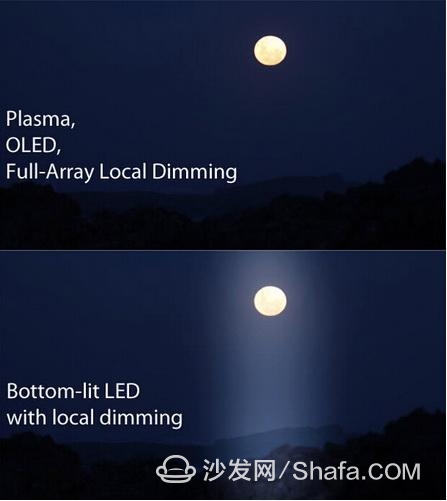With the increasingly powerful features of smart products such as mobile phones and tablets, the use of television is getting lower and lower, but even so, the dominance of home entertainment in TV products cannot be shaken. Faced with the rapid development of the TV market, how to choose a suitable TV product? Now that smart TV products are increasingly focusing on panel technology, what is better with LED TVs and OLED TVs? Xiao Bian brings the advantages and disadvantages of the two major panel technologies to help consumers make better choices.

In fact, today's television has greatly improved its intelligence in comparison with machines that previously only had fixed channels. Not only can you see movie theaters, popular TV shows, you can even download apps and games on the Internet. At the same time, the screen size of TVs is also getting larger and larger, and there are data showing that TV penetration rates of 48å‹ and above in the first half of 2016 have continued to climb. With the continuous development of television, television manufacturers have improved their research and development in television technology. From the viewer's point of view, the television's visual experience is an important factor affecting their purchase. For the two most common types of TVs currently available: LED LCD TVs and OLED TVs, for consumers who want to buy TV.
Detailed explanation of two common TV panel LEDs and OLEDs
Although plasma TVs used to be popular, LCD TVs and TVs still occupy the market. The LED is called "Light Emitting Diode", which is what we call LED. The LED liquid crystal panel is actually a branch of the LCD panel. It has a high sensitivity to current and requires only a very small current to make it emit light. Therefore, the power consumption required for use is small. This feature allows the LED panel to blink for a long time without causing damage. Therefore, the LED panel has a long service life.

Currently, LCD TVs are the most widely used type of panel for large-screen TVs. Most of the TVs that consumers purchase at home are LED LCD TVs. However, many people still do not understand the relationship between LCD TVs and LED TVs. In fact, LED TVs are a type of LCD TVs. LED TVs use LED backlight modules instead of traditional backlight sources. Therefore, although the power consumption of LCD TVs is reduced, the brightness, color saturation, and motor performance are all enhanced. Its working mechanism is: “The light-emitting diode has a PN junction chip inside. When the current passes through, the electrons will be pushed to the P pole and react and emit energy. Such energy is displayed in light energy and will show different according to different wavelengths. color.
OLED is called the Organic Light-Emitting Diode, also known as organic electro-optical display or organic light-emitting semiconductor. It was first discovered in the laboratory in 1983. It has a different lighting mechanism from that of LCD TVs, and has the characteristics of self-luminescence, wide viewing angle, sensitive response speed, and low power consumption.

The OLED panel has three layers, namely a hole transport layer, a light emitting layer, and an electron transport layer. When the internal sensitive element receives a direct current, the electrons will shift, combine with the holes, and emit light in the point layer, and generate different colors according to different colors. Unlike LCDs, OLEDs do not require backlights. Their self-illuminating properties make them highly visible and bright. With their responsiveness and thinness, OLED TVs are becoming more and more popular on the market. At the same time, there are also many manufacturers optimistic about OLED TV, still it will be the next boom in the development of the television industry. Although OLED panels started relatively late, the level of technological development is still not comparable to that of LCD TVs, and the yield rate is also low, but they are still questioned by the short life span and image blur. However, with the recent increase in the investment in OLED TVs, the current OLED product yield can reach 80%, and life expectancy and picture quality have also greatly improved.
Which good consumer should choose LED TV and OLED TV?
At present, LED and OLED are considered to be the two major “camps†in the TV industry. TV manufacturers have also competed in teams and launched their own flagship products. Then when consumers purchase, it is necessary to select LED LCD TVs, or the recent thunder is positive. OLED TV? Let's make a comparison based on the most common points on TV and see if that suits you better.
Although not popular a few years ago, the UHD TV market share has increased to 36.6% in 2015. It can be seen that consumers' demand for television resolution is increasing. And LED LCD TVs and OLED TVs all have 4K ultra-high definition resolution products. Once the public thought that 4K × 2K level of high-resolution display technology, and OLED TV due to technical issues in the slightest lack of resolution. However, in fact, current OLED TVs are also equipped with 4K ultra-high resolution products, and they are also very strong in terms of definition. However, it is worth mentioning that the current 8K resolution has been applied in LED LCD TVs, Sharp also demonstrated 8K OLED panel technology. Therefore, the two are tied in terms of resolution and resolution.

When watching TV, good picture quality is one of the focuses of everyone's attention. What about the performance of the two in terms of picture quality? First of all, from the perspective of contrast, OLED TVs have great advantages in black due to their self-luminous characteristics. In the dark state of the TV, the OLED TV shows a deeper black, while the LED TV has a black impure phenomenon. Ordinary LED TVs, due to the use of backlight technology, have a certain influence on local dimming. From the details, although OLED has excellent black performance, but the black details are still insufficient performance, LED LCD TVs perform better in details. In terms of color, LED liquid crystal panels can not emit color, need to be obtained by the color filter to obtain the desired color, and OLED can self-luminous display red, green and blue three colors, in the color gamut is indeed superior. In terms of brightness, with the HDR technology slowly becoming the "standard", LED LCD TVs have a great leap in brightness. However, the self-luminous nature of OLEDs allows the light source to pass through the filter plate without the light attenuating, so both have advantages.
From the viewing point of view, the LED liquid crystal television is likely to cause light leakage due to the different and uneven backlight positions, resulting in a reduced perception. The self-luminous effect of OLED TVs can solve this problem. In terms of TV life, OLEDs are not as short-lived as the rumors said. OLED TVs and LED LCD TVs are generally considered to have almost the same service life. As far as everyone's concern is concerned, LCD TVs are leading the market at a low price, and OLEDs are relatively expensive because of cost issues. However, as the penetration rate continues to increase, OLED TV prices will also show a downward trend.
Edit summary:
For consumers, TV is not just a product used by one person, but also a bond connecting the family. Many people have been confused by a series of terms before buying TV. In fact, mainstream TVs are still dominated by LED LCD TVs, and OLEDs are constantly catching up as "rising stars." For those who love high image quality and can invest funds, OLED TV may be able to meet your needs. For those who feel the sensation of TV and create an atmosphere that they want to be able to buy TV at a lower price, LED LCD TVs are also a good choice.
Smart TV/box information can focus on smart TV information network sofa butler (http://), China's influential TV box and smart TV website, providing information, communication, TV boxes, smart TVs, smart TV software, etc. Answering questions.